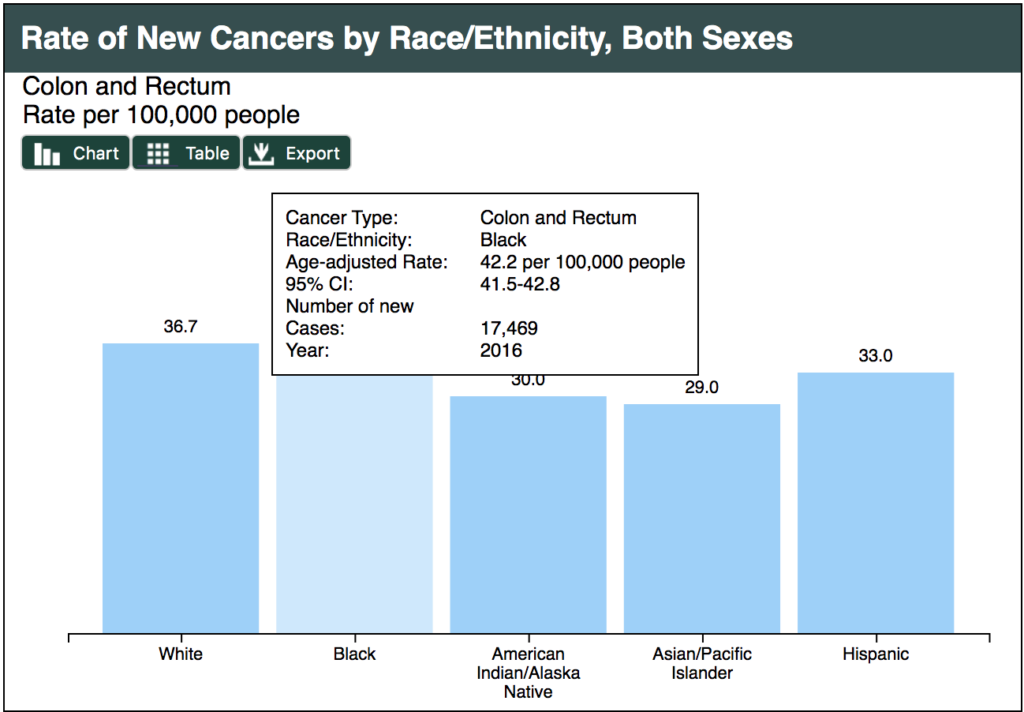
Get Screened
For African Americans, screening for colon cancer earlier could mean longer life.
Getting Tested
About Testing
A colonoscopy allows the doctor to look inside the entire rectum and colon while a patient is sedated. A flexible, lighted tube called a colonoscope is inserted into the rectum and the entire colon to look for polyps or cancer. During this procedure, a doctor can remove polyps or other tissue for examination (see “Biopsy” in the Diagnosis section). The removal of polyps can also prevent colorectal cancer.
Computed tomography (CT or CAT) colonography
CT colonography, sometimes called virtual colonoscopy, is a screening method being studied in some centers. It requires interpretation by a skilled radiologist to provide the best results. A radiologist is a doctor who specializes in obtaining and interpreting medical images. However, CT colonography may be an alternative for people who cannot have a standard colonoscopy due to the risk of anesthesia, which is medication to block the awareness of pain, or if a person has a blockage in the colon that prevents a full examination.
Sigmoidoscopy
A sigmoidoscopy uses a flexible, lighted tube that is inserted into the rectum and lower colon to check for polyps, cancer, and other abnormalities. During this procedure, a doctor can remove polyps or other tissue for later examination. The doctor cannot check the upper part of the colon, the ascending and transverse colon, with this test. This screening test allows for the removal of polyps, which can also prevent colorectal cancer, but if polyps or cancer are found using this test, a colonoscopy to view the entire colon is recommended.
Fecal occult blood test (FOBT) and fecal immunochemical test (FIT)
A fecal occult blood test is used to find blood in the feces, or stool, which can be a sign of polyps or cancer. A positive test, meaning that blood is found in the feces, can be from causes other than a colon polyp or cancer, including bleeding in the stomach or upper GI tract and even eating rare meat or other foods. There are 2 types of tests: guaiac (FOBT) and immunochemical (FIT). Polyps and cancers do not bleed continually, so FOBT must be done on several stool samples each year and should be repeated every year. Even then, this screening test provides a fairly small reduction in deaths from colorectal cancer, around 30% if done yearly and 18% if done every other year.
Double contrast barium enema (DCBE)
For patients who cannot have a colonoscopy, an enema containing barium is given, which helps make the colon and rectum stand out on x-rays. A series of x-rays is then taken of the colon and rectum. In general, most doctors would recommend other screening tests because a barium enema is less likely to detect precancerous polyps than a colonoscopy, sigmoidoscopy, or CT colonography.
Stool DNA tests
This test analyzes the DNA from a person’s stool sample to look for cancer. It uses changes in the DNA that occur in polyps and cancers to find out if a colonoscopy should be done.
Test Preparation
How to prepare for the various methods of screening; some require more prep than others
To prepare for the test, you may be asked to follow a special diet for a day or two before the test. You will also need to clean out your colon with strong laxatives (called a bowel prep) and sometimes with enemas, as well. Most people are sedated during the test.
What to do after getting screened (how to deal with getting screened)
Because air is pumped into the colon and rectum during the test, people sometimes feel bloated, have gas pains, or have cramping for a while after the test until the air passes out.
Some people may have low blood pressure or changes in heart rhythm from the sedation during the test, but these are rarely serious.
If a polyp is removed or a biopsy is done during the colonoscopy, you might notice some blood in your stool for a day or 2 after the test. Serious bleeding is uncommon, but in rare cases, bleeding might need to be treated or can even be life-threatening.
Colonoscopy is a safe procedure, but in rare cases the colonoscope can puncture the wall of the colon or rectum. This is called a perforation. Symptoms can include severe abdominal (belly) pain, nausea, and vomiting. This can be a major (or even life-threatening) complication, because it can lead to a serious abdominal (belly) infection. The hole may need to be repaired with surgery. Ask your doctor about the risk of this complication.
Have a story to share?
Tell us about it.


